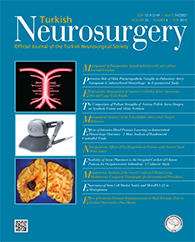2American Hospital, Department of Physical Medicine and Rehabilitation, Istanbul, Turkey
3Koc University, School of Medicine, Department of Physical Medicine and Rehabilitation, Istanbul, Turkey
4American Hospital, Department of Radiology, Istanbul, Turkey
5American Hospital, Department of Neurosurgery, Istanbul, Turkey
6Koc University, School of Medicine, Department of Neurosurgery, Istanbul, Turkey DOI : 10.5137/1019-5149.JTN.12350-14.1 Aim: To investigate high-intensity zone (HIZ) changes after lumbar posterior dynamic instrumentation.
Material and Methods: Our study included 53 patients: 27 patients in group 1, 26 patients in group 2. All patients had one or two levels of degenerative disc disease with an HIZ confirmed by magnetic resonance imaging (MRI). Group 1 underwent one- or two-level dynamic lumbar posterior instrumentation. Group 2 was treated conservatively with an exercise program. Patients were evaluated using MRI, a numerical visual analog pain scale (VAS), and the Oswestry Disability Index (ODI) at baseline, at 1 year after surgery, and at final follow-up evaluation.
Results: The mean duration of follow-up was 49.3 months in group 1 and 47.19 months in group 2. The baseline VAS and ODI scores were similar for both groups. The mean VAS score of group 1 was significantly improved at 1 year after surgery and at final follow-up. The mean ODI value was lower in group 1 than in group 2 at 1 year and at final follow-up. Pfirrmann grades in group 1 significantly differed at 1 year and at final follow-up but did not change in group 2. The number of HIZs significantly decreased in from baseline to 1 year and from baseline to final follow-up in group 1 but did not differ in group 2.
Conclusion: Dynamic lumbar stabilization systems are promising. Observations such as Pfirrmann grade improvements and disappearance of HIZs are concordant with improvements in VAS and ODI scores demonstrate that dynamic stabilization systems may provide an environment for regeneration.
Keywords : High-intensity zone, Degenerative disc disease, Posterior dynamic instrumentation




